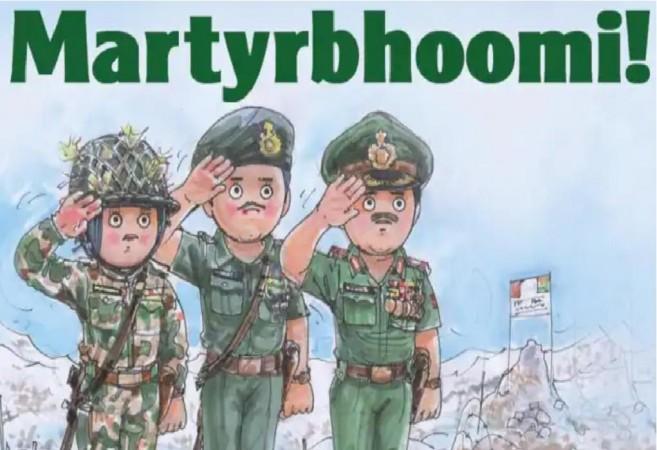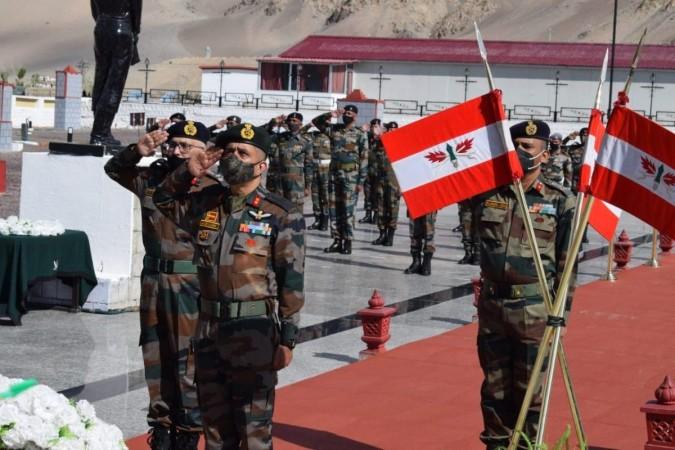Last year on this day, while an exhausted country was battling a strange lethal virus and the aftermaths of resulting lockdowns to curb its spread, soldiers of 16 Bihar regiment put up their brave best to face a stand-off with the Chinese troops in the Galwan valley of Ladakh.
A video released by the Chinese media in February this year showed hundreds of 'unarmed' uniformed soldiers facing each other with sticks and shields in cold Galwan waters. The 'skirmish' as reported by top media channels witnessed the loss of 20 soldiers of the 16 Bihar Regiment including a Colonel rank officer.
Paying homage to Martyrs

On Tuesday morning, the Indian Army's Fire and Fury Corps paid a tribute to the soldiers who sacrificed their lives fighting the intrusive Chinese PLA.
Major General Akash Kaushik, Chief of Staff, Fire and Fury Corps, laid a wreath at the War Memorial in Leh on the occasion. "COAS General MM Naravane and all ranks of Indian Army pay homage to the Bravehearts who made supreme sacrifice in Galwan Valley Ladakh while defending the territorial integrity and sovereignty of the country. Their valour will be eternally etched in the memory of the Nation," the Indian Army spokesperson stated on the microblogging site.

In Telangana, Minister for Municipal Administration and Urban Development KT Rama Rao unveiled the statue of Colonel Santosh Babu at the court center in Suryapet. The junction at which the statue has been named after the Galwan clash hero, according to The Print.
What happened on June 15, 2020?
A Scroll article from last year explained the reason behind the stand-off according to which Chinese troops intruded into Indian territory in the Galwan Valley to block work on a link road branching off from the Darbuk-Shyok-Daulat Beg Oldi Road. India had to respond. The link road was part of an infrastructure project on the Indian side of the Line of Actual Control.
China does not want India to improve its infrastructure so that the country remains vulnerable to a 1962-type attack. Chinese troops also encroached upon Indian territory on the northern bank of the Pangong Tso, between "fingers" four to eight. They have built bunkers and other fortifications there and refused to dismantle them, claiming that the area belongs to China.

Here's the timeline of events that led to the violent clashes between India and China in Galwan Valley in Eastern Ladakh.
Following Lieutenant General talks that concluded on June 6 between India and China, symbolic disengagement took place in an attempt to resolve the months-long border standoff in Eastern Ladakh region.
After the token disengagement, the Chinese came back again mid-week and erected up a fresh tent, just in 2 days of the disengagement plan agreed between the two Generals. A brawl ensued between the soldiers of the two armies which resulted in the incineration of the Chinese tent.
The Chinese troops returned only to come back with a larger platoon of troopers over the weekend. Stone pelting took place between the two sides on Sunday, June 14.
Violent clashes broke out on Monday (June 15) evening at the brink with a high gorge towards the Galwan river. According to the sources, skirmishes intensified and many Indian soldiers jumped into the valley in a bid to save themselves. The military confrontation between the Indian and Chinese troopers took place a day before the Major Generals of the sides were going to meet to take the disengagement plan further ahead.

As the Chinese refused to back off, an unarmed team of patrol led by Commanding Officer Colonel Babu of the 16 Bihar Regiment set out to discuss with the Chinese counterpart. However, the Chinese held their ground and refused to honour the agreed disengagement plan between the Lt Generals on June 6. The Chinese side deliberately stoked the situation by attacking the unarmed Indian patrol team with boulders, stones, iron rods, clubs wrapped in barbed wire and wooden logs with nails around them. The Indian team retaliated. The Indian military sources confirmed that no firearms were used in the clashes and that most of the injuries sustained were due to the stone-pelting and the use of iron rods by the Chinese side.
The CO of the 16 Bihar Regiment sustained serious injuries in the initial attack by the Chinese troopers. He, along with an injured havaldar was immediately rescued and taken back, leaving behind the injured soldiers, who were taken captive by the Chinese side.
After a hiatus of 40 minutes, a Major led the same unit to the site and mounted an attack against the Chinese intruders. Things escalated precipitously from that point onwards.
The Indian troops attacked the Chinese soldiers with brute power and inflicted serious life-threatening injuries to about 55 Chinese soldiers. The bloody brawl resulted in many casualties on the Chinese side but the sources informed that the exact number of fatalities cannot be determined.
The fighting was happening near the ridge and many of the soldiers perished after being pushed down the brink into the fast-moving Galwan river. The Indian unit was massively outnumbered by the Chinese, according to the sources. This is the moment when several casualties on the Indian and Chinese side happened. Sources also inform that there was a brigadier-level Chinese officer on the post waving for peace and asking the two sides to stop the clashes.
Fierce fist fighting continued late into the night and stones, metal clubs wrapped in barbed wire were used, resulting in head injuries to many. The clash continued for about 3 hours.
Fighting halted well past midnight. Bodies of the soldiers were fished from the river while many injured succumbed to their injuries by morning, sources said.
Following the violent clashes between the Indian and Chinese forces, the multiple Colonel-to-Colonel-level talks from both sides happened at the very same post during the day. The Indian Army has now taken over the control of the Indo-Tibetan Border Police (ITBP) posts.

















